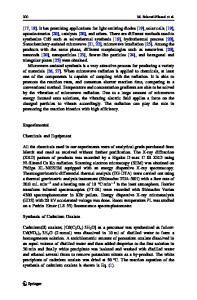Synthesis and characterization of microwave absorbing material
- PDF / 1,518,333 Bytes
- 9 Pages / 595.276 x 790.866 pts Page_size
- 96 Downloads / 358 Views
ORIGINAL PAPER
Synthesis and characterization of microwave absorbing material G R Mishra1, G Nath2* and R Paikaray1 1
Department of Physics, Ravenshaw University, Cuttack, Odisha 753003, India
2
Department of Physics, V S S University of Technology, Sambalpur, Odisha, India Received: 14 March 2019 / Accepted: 09 September 2019
Abstract: The present work encloses the application of ultrasonically blended chemicals in the treatment of waste materials like sugarcane bagasse fiber for presynthesis of microwaves absorbing material/radar absorbing material for different applications. The optimized blended chemicals with alcohol blended acrylic acid are determined by computation of different acoustic parameters with the propagation of ultrasonic wave in frequency ranges from 1 to 5 MHz. The optimum blend of acrylic acid with methanol with 0.4 concentrations, out of all other alcohol group, shows its best characteristics in all frequency ranges for the modification of surface of sugarcane bagasse. The study of elemental dispersion images of untreated and treated sugarcane bagasse fiber signifies the suitability of the material for synthesis of microwave absorbing materials. The presence of many reaction sites on the treated sugarcane bagasse fiber makes its suitability for synthesis of biomaterial. The SEM of treated sugarcane bagasse fiber gives significant explanation for absorption of incident microwave radiation on the biomaterial prepared from this waste. The reflection loss of the synthesized biocomposite shows significant effect of the treatment of ultrasonic wave for microwave absorption at 10 GHz in X-band frequency range. Keywords: Biowaste; Sugarcane bagasse fiber; Ultrasonic wave; Intermolecular interaction; Acoustic parameters; Microwaves absorbing material PACS Nos.: 41.20.Jb; 34.35. ? a; 32.30.Bv
1. Introduction Biowastes are the major component as reinforcement for any advance functional material like biocomposites. The lignocellulosic part of biowaste basically is composed of a varying amount of lignin (10–25 wt%), cellulose (40–60 wt%) and hemicelluloses (20–40 wt%), respectively [1]. The elementary constituents such as carbon, oxygen and other inorganic materials are actually the deciding factors for fabrication of biocomposites. The high percentage of carbon (44.44%) and oxygen (49.39%) in cellulose makes it possible for preparation of activated carbon after proper treatment and surface bleaching of the biowaste. The high-porosity structure, surface area and low cost of preparation of activated carbon have drawn more attention for fabrication of energy storage device like
*Corresponding author, E-mail: [email protected]
capacitors, microwave absorbing materials (MAM), stealth material for stealth technology and many more [2]. The poor moisture resistance and low mechanical properties of biocomposites limit its application to interior and nonstructural design. In composite material, the interface between matrix and fiber has a significant contribution to most of the characteristics of compo
Data Loading...











